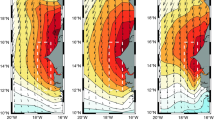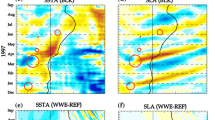Abstract
Based on satellite data on sea surface temperature (1985–2018) and surface wind (1992–2017), the parameters of low-frequency variability are calculated and analyzed for the intensity of the Canary, Benguela, Californian, Peruvian, and Chilean upwellings. It is shown that all the analyzed large-scale wind-driven upwellings have intensified in the recent 30 years. The main contribution to this intensification is made by the strengthening of offshore wind. An exception is the Peruvian upwelling, where a trend caused by the wind stress curl intensification prevails.



Similar content being viewed by others
REFERENCES
L. A. Dukhova and V. V. Sapozhnikov, “Hydrochemical Parameters of Primary Production in the Zone of the Peruvian and Canary Upwellings,” Trudy VNIRO, 152 (2014) [in Russian].
A. B. Polonskii and A. N. Serebrennikov, “Long-Term Sea Surface Temperature Trends in the Canary Upwelling Zone and Their Causes,” Izv. Atmos. Oceanic Physics, No. 9, 54 (2018).
A. B. Polonskii and A. N. Serebrennikov, “On the Change in the Ocean Surface Temperature in the Benguela Upwelling Region. Part I: Season Cycle,” Izv. Atmos. Oceanic Physics, No. 9, 55 (2019).
A. B. Polonskii and A. N. Serebrennikov, “Sea Surface Temperature Changes in the Zone of the Benguela Upwelling. Part 2: Long-term Trends,” Issledovanie Zemli iz Kosmosa, No. 4 (2019) [in Russian].
A. N. Serebrennikov, “An Improved Technique for the Retrieval of Coastal Upwelling Indices from Satellite Data,” Sovremennye Problemy Distantsionnogo Zondirovaniya Zemli iz Kosmosa, No. 5, 15 (2018) [in Russian].
A. Bakun, “Global Climate Change and Intensification of Coastal Ocean Upwelling,” Science, 247 (1990).
A. Bakun, B. A. Black, S. J. Bograd, M. Garcia-Reyes, A. J. Miller, R. R. Rykaczewski, and W. J. Sydeman, “Anticipated Effects of Climate Change on Coastal Upwelling Ecosystems,” Curr. Clim. Change Rep., 1 (2015).
A. Bakun, D. B. Field, A. Redondo-Rodriguez, and S. J. Weeks, “Greenhouse Gas, Upwelling-favorable Winds, and the Future of Coastal Ocean Upwelling Ecosystems,” Global Change Biology, No. 4,16 (2010).
A. Belmadani, V. Echevin, F. Codron, K. Takahashi, and C. Junquas, “What Dynamics Drive Future Wind Scenarios for Coastal Upwelling off Peru and Chile?”, Climate Dynamics, No. 7–8,43 (2014).
M. E. Carr, “Estimation of Potential Productivity in Eastern Boundary Currents Using Remote Sensing,” Deep-Sea Res., Part II, No. 1–3, 49 (2002).
M. E. Carr and E. J. Kearns, “Production Regimes in Four Eastern Boundary Current Systems,” Deep-Sea Res., Part II, No. 22–26,50 (2003).
F. P. Chavez and M. Messie, “A Comparison of Eastern Boundary Upwelling Ecosystems,” Prog. Oceanogr., No. 1–4, 83 (2009).
M. Garcia-Reyes, W. J. Sydeman, D. S. Schoeman, R. R. Rykaczewski, B. A. Black, A. J. Smit, and S. J. Bograd, “Under Pressure: Climate Change, Upwelling, and Eastern Boundary Upwelling Ecosystems,” Front. Mar. Sci., 2 (2015).
A. Huyer, “Coastal Upwelling in the California Current System,” Prog. Oceanogr., 12 (1983).
T. Junker, M. Schmidt, and V. Mohrholz, “The Relation of Wind Stress Curl and Meridional Transport in the Benguela Upwelling System,” J. Mar. Systems, 143 (2015).
R. Koenker and G. Bassett Jr., “Regression Quantiles,” Econometrica, Nо. 1, 46 (1978).
R. Koenker and K. Hallock, “Quantile Regression,” J. Econ. Perspectives, 15 (2001).
T. Lamont, M. Garcia-Reyes, S. J. Bograd, C. D. van der Lingen, and W. J. Sydeman, “Upwelling Indices for Comparative Ecosystem Studies: Variability in the Benguela Upwelling System,” J. Mar. Systems, 188 (2018).
D. Macias, M. R. Landry, A. Gershunov, A. J. Miller, and P. J. S. Franks, “Climatic Control of Upwelling Variability along the Western North American Coast,” PLoS ONE, 7 (2012).
N. Narayan, A. Paul, S. Mulitza, and M. Schulz, “Trends in Coastal Upwelling Intensity during the Late 20th Century,” Ocean Sci.,6 (2010).
R. K. Pachauri, M. R. Allen, V. R. Barros, J. Broome, W. Cramer, R. Christ, and J.-P. van Ypersele, Climate Change 2014: Synthesis Report. Contribution of Working Groups I, II and III to the Fifth Assessment Report of the Intergovernmental Panel on Climate Change, Ed. by R. Pachauri and L. Meyer (IPCC, Geneva, Switzerland, 2014).
L. A. Parsons, G. R. Loope, J. T. Overpeck, T. R. Ault, R. Stouffer, and J. E. Cole, “Temperature and Precipitation Variance in CMIP5 Simulations and Paleoclimate Records of the Last Millennium,” J. Climate, No. 22, 30 (2017).
D. Pauly and V. Christensen, “Primary Production Required to Sustain Global Fisheries,” Nature, 374 (1995).
A. Polonsky, The Ocean’s Role in Climate Change (Cambridge Scholars Publishing, Newcastle, UK, 2019).
R. R. Rykaczewski, J. P. Dunne, W. J. Sydeman, M. Garcia-Reyes, B. A. Black, and S. J. Bograd, “Poleward Intensification of Coastal Upwelling in Response to Global Warming,” Geophys. Res. Lett.,42 (2015).
S. Seabold and J. Perktold, “Statsmodels: Econometric and Statistical Modeling with Python,” in Proceedings of the 9th Python in Science Conference (2010).
R. Seabra, R. Varela, A. M. Santos, M. Gomez-Gesteira, C. Meneghesso, D. S. Wethey, and F. P. Lima, “Reduced Nearshore Warming Associated with Eastern Boundary Upwelling Systems,” Front. Mar. Sci.,6 (2019).
N. Tim, E. Zorita, and B. Hunicke, “Decadal Variability and Trends of the Benguela Upwelling System as Simulated in a High Ocean-only Simulation,” Ocean Sci., 11 (2015).
Upwelling: Mechanisms, Ecological Effects and Threats to Biodiversity, Ed. by W. E. Fischer and A. B. Green (Nova Science Publishers, Inc., New York, USA, 2013).
R. Varela, I. Alvarez, F. Santos, M. DeCastro, and M. Gomez-Gesteira, “Has Upwelling Strengthened along Worldwide Coasts over 1982–2010?”, Sci. Rep., 5 (2015).
D. Wang, T. C. Gouhier, B. A. Menge, and A. R. Ganguly, “Intensification and Spatial Homogenization of Coastal Upwelling under Climate Change,” Nature, 518 (2015).
ACKNOWLEDGMENTS
The authors thank an anonymous reviewer for the friendly review and constructive comments.
Funding
The research was performed in the framework of the State Assignment theme 0012-2019-0002 (“Fundamental Studies of Processes in the Climate System, Which Define the Global and Regional Spatiotemporal Variability of the Environment”).
Author information
Authors and Affiliations
Corresponding author
Additional information
Russian Text ©The Author(s), 2020, published in Meteorologiya i Gidrologiya, 2020, No. 5, pp. 86–95.
About this article
Cite this article
Polonskii, A.B., Serebrennikov, A.N. Intensification of Eastern Boundary Upwelling Systems in the Atlantic and Pacific Oceans . Russ. Meteorol. Hydrol. 45, 422–429 (2020). https://doi.org/10.3103/S1068373920060059
Received:
Revised:
Accepted:
Published:
Issue Date:
DOI: https://doi.org/10.3103/S1068373920060059




